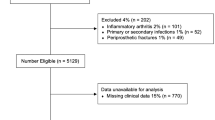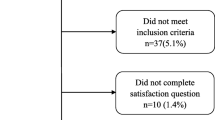Abstract
Objectives
The aim of this study was to identify threshold values in the pre- and post-operative Oxford knee score (OKS), and change in the score for differing levels of patient satisfaction with their total knee replacement (TKR).
Methods
We prospectively collected pre-operative and 1-year post-operative OKS for 2392 patients undergoing a TKR. Patient satisfaction was categorically assessed, according to whether they were: very satisfied, satisfied, neutral, and unsatisfied. Receiver operating characteristic curve analysis was used to identify thresholds in the OKS score that identified each level of patient satisfaction.
Results
The post-operative OKS was the most accurate predictor of the level of patient satisfaction (area under the curve = 0.86). Very satisfied patients had a threshold value in the post-operative OKS of ≥36, which decreased to ≥27 points for satisfied patients, and further still to ≤25 for unsatisfied patients.
Conclusion
The threshold values, we have identified for the different levels of satisfaction using the post-operative OKS, which is the most accurate predictor, can be used to predict level of patient satisfaction and give quantification of the OKS.




Similar content being viewed by others
References
Dawson J, Doll H, Fitzpatrick R, Jenkinson C, Carr AJ (2010) The routine use of patient reported outcome measures in healthcare settings. BMJ 340:c186
Dawson J, Fitzpatrick R, Murray D, Carr A (1998) Questionnaire on the perceptions of patients about total knee replacement. J Bone Joint Surg Br 80:63–69
Department for Health. Equity and excellence: liberating the NHS. 2010. http://www.dh.gov.uk/en/Publlicationsandstatistics/Publications/PubicationsPolicyAndGuidance/DH_117353 (date last accessed 16th Decemeber 2012)
Judge A, Arden NK, Kiran A, Price A, Javaid MK, Beard D, Murray D, Field RE (2012) Interpretation of patient-reported outcomes for hip and knee replacement surgery: identification of thresholds associated with satisfaction with surgery. J Bone Joint Surg Br 94:412–418
Pearse AJ, Hooper GJ, Rothwell A, Frampton C (2010) Survival and functional outcome after revision of a unicompartmental to a total knee replacement: the New Zealand national joint registry. J Bone Joint Surg Br 92:508–512
Keenan AC, Wood AM, Arthur CA, Jenkins PJ, Brenkel IJ, Walmsley PJ (2012) Ten-year survival of cemented total knee replacement in patients aged less than 55 years. J Bone Joint Surg Br 94:928–931
Kalairajah Y, Azurza K, Hulme C, Molloy S, Drabu KJ (2005) Health outcome measures in the evaluation of total hip arthroplasties–a comparison between the Harris hip score and the Oxford hip score. J Arthroplast 20:1037–1041
Norman GR, Sloan JA, Wywich KW (2003) Interpretatation of the changes in health-related quality of life: the remarkable universality of half a standard deviation. Med Care 41:582–592
Schmitt JS, Di Fabio RP (2004) Reliable change and minimum difference (MID) proportions facilitated group responsivemess comparisons using indvidual threshold criteria. J Clin Epidemiol 57:1008–1019
Scott CEH, MacDonald D, Howie CR, Biant LC (2010) Predicting Patient Dissatisfaction following Total Knee Replacement: A prospective study of 1217 cases. J Bone Joint Surg Br 92-B:1253–1258
General Register Office for Scotland. http://www.gro-scotland.gov.uk/files2/stats/gros-mid-2008-population-estimates-scotland-population-estimates-by-sex-age-and-administrative-area/j1075008.htm (date last accessed 16th Decemeber 2012)
Farrar JT, Young JP Jr, LaMoreaux L, Werth JL, Poole RM (2001) Clinical importance of changes in chronic pain intensity measured on an 11-point numerical pain rating scale. Pain 94:149–158
Scott CE, Howie CR, MacDonald D, Biant LC (2010) Predicting dissatisfaction following total knee replacement: a prospective study of 1217 patients. J Bone Joint Surg Br 92:1253–1258
Brander V, Gondek S, Martin E, Stulberg SD (2007) Pain and depression influence outcome 5 years after knee replacement surgery. Clin Orthop Relat Res 464:21–26
Robertsson O, Dunbar M, Pehrsson T, Knutson K, Lidgren L (2000) Patient satisfaction after knee arthroplasty: a report on 27,372 knees operated on between 1981 and 1995 in Sweden. Acta Orthop Scand 71:262–267
Baker PN, van der Meulen JH, Lewsey J, Gregg PJ (2007) The role of pain and function in determining patient satisfaction after total knee replacement. Data from the national joint registry for England and Wales. J Bone Joint Surg Br 89:893–900
Johnston L, Maclennan G, McCormack K, Ramsay C, Walker A (2009) The Knee Arthroplasty Trial (KAT) design features, baseline characteristics, and two-year functional outcomes after alternative approaches to knee replacement. J Bone Joint Surg Am 91:134–141
Clement ND, MacDonald D, Howie CR, Biant LC (2011) The outcome of primary total hip and knee arthroplasty in patients aged 80 years or more. J Bone Joint Surg Br 93:1265–1270
Scott CE, Bugler KE, Clement ND, MacDonald D, Howie CR, Biant LC (2012) Patient expectations of arthroplasty of the hip and knee. J Bone Joint Surg Br 94:974–981
Conflict of interest
The authors declare no conflict of interest with the content of this study.
Author information
Authors and Affiliations
Corresponding author
Rights and permissions
About this article
Cite this article
Clement, N.D., Macdonald, D. & Burnett, R. Predicting patient satisfaction using the Oxford knee score: where do we draw the line?. Arch Orthop Trauma Surg 133, 689–694 (2013). https://doi.org/10.1007/s00402-013-1728-3
Received:
Published:
Issue Date:
DOI: https://doi.org/10.1007/s00402-013-1728-3




